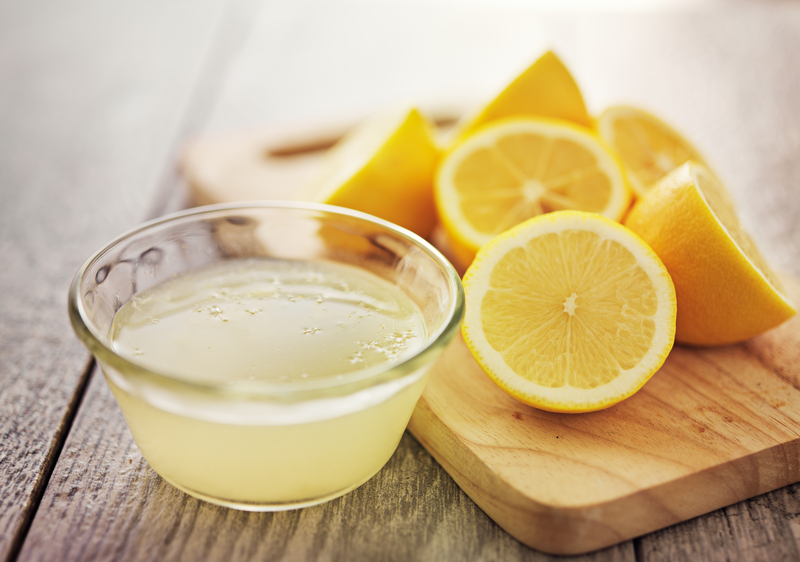Jewelry Liberation: Mastering Cleaning Techniques
Posted on 21/06/2025
Jewelry Liberation: Mastering Cleaning Techniques
Jewelry is more than just an accessory--it's an extension of our personality, a celebration of milestones, and a keeper of memories. But over time, even the brightest gemstones and shiniest metals lose their luster. Jewelry cleaning mastery isn't just for professionals; with a reinvigorated approach, you can restore your pieces' radiance at home. In this comprehensive guide, we will delve into jewelry liberation--the art and science of freeing your precious items from dirt, tarnish, and time's touch. Get ready to learn jewel care secrets that breathe new life into your treasures.

Why Effective Jewelry Cleaning Techniques Matter
It's easy to overlook routine jewelry maintenance, but neglect can do serious harm. Dirt, oil, and environmental pollutants accumulate, making gemstones appear dull and causing metals to corrode. Regular cleaning not only preserves shine but also protects structural integrity. Mastering proper jewelry cleaning techniques ensures every link, clasp, and setting remains pristine and secure.
The Risks of Neglected Jewelry
- Tarnishing: Silver and gold jewelry loses its brilliance when exposed to air and moisture.
- Gemstone Dulling: Lotions, makeup, and everyday grime can form a cloudy film on sapphires, diamonds, and pearls.
- Structural Weakness: Built-up debris may stress prongs and mounts, risking gemstone loss.
- Expanded Repair Costs: Damaged pieces often need costly professional fixes.
Seeking jewelry liberation through effective cleansing means more than keeping up appearances--it's about investing in lasting luxury.
Understanding Your Jewelry: Materials and Methods
Not all jewelry is alike, and neither are their cleaning requirements. Before diving into a cleaning session, it's essential to identify what you're working with. Misapplied methods can permanently damage delicate gems or soft metals. Let's explore the categories:
Precious Metals
- Gold: Resistant to tarnishing but can scratch; avoid abrasive techniques.
- Silver: Prone to oxidation and tarnish; requires gentle yet effective polishes.
- Platinum: Durable but accumulates dirt and scratches over time.
Gemstones
- Diamonds: Tough yet prone to collecting oil.
- Sapphires and Rubies: Durable but susceptible to harsh chemicals.
- Emeralds, Opals, Pearls: Softer and porous; need the most delicate care.
Costume Jewelry
Made with plated metals or non-gem components, these pieces require different cleaning approaches to avoid flaking or fading.
Jewelry Liberation: The Best At-Home Cleaning Techniques
Ready to liberate your jewelry from months (or years) of neglect? Here's your detailed, step-by-step guide to rejuvenate every type of piece.
General Cleaning Supplies You'll Need
- A soft, lint-free microfiber cloth
- Mild dish soap
- Warm distilled water
- Soft-bristle toothbrush or baby brush
- Small, clean bowls
- Cotton swabs
- Baking soda, ammonia, or vinegar (for stubborn tarnish)
- A dedicated jewelry polishing cloth, if available
Cleaning Gold Jewelry
- Soak gently: Add a drop of mild dish soap to warm distilled water. Place your gold pieces in the solution for 10-15 minutes.
- Brush softly: Use the toothbrush to clean intricate details and settings, taking care not to scratch the metal.
- Rinse: Swish the items in a fresh bowl of clean water. Avoid washing directly under the tap to prevent loss.
- Dry and buff: Pat dry with a microfiber cloth, then polish.
Silver Jewelry Liberation: Remove Tarnish Effectively
Silver loves to tarnish! Mastering the right tarnish removal technique is a key step in your jewelry freedom journey.
- Baking Soda Paste: Mix three parts baking soda with one part water. Using a soft cloth, gently apply the paste, working it into crevices. Never use this on soft gemstones or plated silver.
- Rinse and Dry: Clean off all residue with distilled water; dry thoroughly with a soft towel.
- For severe tarnish: Try a specialized silver dip (read all instructions) or line a bowl with aluminum foil, add baking soda and hot water, and gently place the silver item inside. The chemical reaction lifts tarnish naturally.
Gemstone Jewelry: Shine Without Damage
- Diamonds, Rubies, Sapphires: Soak in warm soapy water for 10 minutes. Gently brush around prongs and settings. Rinse and pat dry.
- Pearls, Opals, Emeralds: Wipe gently with a damp (not wet) soft cloth. Never soak. Air dry flat to avoid stretching threads on pearl necklaces.
- Turquoise, Amber, Other Organics: Avoid all chemicals. Wipe with a dry or barely damp cloth only.
Costume Jewelry Liberation: Gentle Yet Effective
- Care with Plating: Use a barely damp cloth with a drop of mild dish soap. Gently wipe, taking care not to over-wet or rub the finish off.
- Detailing: Use cotton swabs to get into crevices. Do not soak!
- Finishing Touch: Air dry completely before storing to prevent rust or tarnish.
Advanced Jewelry Cleaning Tips: Master Class
Ultrasonic Cleaners: When and How to Use
Ultrasonic jewelry cleaners use sound waves to dislodge deeply entrenched dirt. While effective for solid gold, platinum, and hard gems (like diamonds), never use them for pearls, opals, emeralds, or costume jewelry. Always check the manufacturer's guidelines.
The Power of Steam Cleaning
Steam cleaners are reserved for the pro jeweler's bench, but you can purchase home-use models. They work well on metallic and diamond-heavy pieces, blasting away residues. As always, avoid soft or porous stones.
DIY Natural Cleaning Solutions
- Club Soda: Restores bubble and shine to diamonds and sapphires.
- Effervescent Denture Tablets: Dissolve in water for a gentle but effective soak for rugged pieces.
- White Vinegar: Restores shine to gold and gemstone jewelry with a quick 15-minute soak--make sure to rinse thoroughly.
Be cautious: Even "natural" solutions can harm sensitive items, so always spot test first.
The Don'ts of Jewelry Cleaning
- Never use harsh household cleaners (bleach, chlorine, acetone)--they can irreversibly destroy metals and stones.
- Avoid abrasive materials (toothpaste, scouring pads) which scratch and wear down surfaces.
- Don't soak porous or glued pieces--moisture infiltrates and loosens adhesives, destroys structure, and discolors gems.
- Don't expose jewelry to extreme heat or sudden temperature changes (it causes cracking, especially in gemstones).
Expert Tips for Jewelry Care and Long-Term Maintenance
Mastering cleaning techniques is just the beginning. Follow these expert protocols to ensure jewelry liberation lasts:
- Clean jewelry regularly: Once every few weeks, refresh your pieces and inspect for signs of wear or loose settings.
- Store properly: Use fabric-lined boxes or pouches. Keep different metals separate to prevent scratches and tarnish transfer.
- Avoid contact with chemicals: Remove rings and bracelets before applying lotions, perfumes, or hair products.
- Remove jewelry before exercising, swimming, or cleaning: Sweat and chemicals in pools can degrade metals and gems.
- Consider professional inspections: Yearly check-ups by a jeweler can catch issues early, preventing lost stones or structural damage.
When To Seek Professional Jewelry Cleaning
Home cleaning is excellent for routine maintenance, but sometimes only a professional can restore true brilliance or tackle deep-set grime, especially in vintage or high-value items. Jewelers use ultrasonic, steam, and specialized chemical treatments tailored to each material. Always consult a professional if:
- Your jewelry contains fragile or rare stones
- You notice loose prongs, missing pieces, or damaged settings
- The item has significant sentimental or monetary value
Eco-Friendly and Sustainable Jewelry Cleaning Options
The concept of jewelry liberation can extend beyond aesthetics--aim for eco-conscious methods. Opt for biodegradable soaps, microfiber cloths, glass rather than plastic storage, and minimize the use of chemicals. You can even find green-certified professional jewelers specializing in both cleaning and sustainable craftsmanship.

FAQs About Jewelry Liberation and Cleaning Techniques
How often should I clean my jewelry?
It depends on frequency of wear. Daily-wear pieces (like engagement rings or watches) benefit from a weekly quick clean and monthly deep cleanse. Items worn rarely can be cleaned before major occasions and after stowing.
Is toothpaste safe for cleaning jewelry?
No. Toothpaste is abrasive and can scratch metals and damage softer stones. Always opt for gentler methods.
What is the safest method for all jewelry types?
A gentle wipe with a damp, lint-free microfiber cloth works for virtually any jewelry type--if in doubt, keep it simple.
Can ultrasonic cleaners damage jewelry?
Yes, especially soft, porous, or glued-in stones. Only use ultrasonic cleaners on sturdy, recommended materials.
Conclusion: Embrace Jewelry Liberation for Brilliance and Longevity
Mastering jewelry cleaning is about more than restoring outward shine; it's a statement of value and care for the pieces that define your style and memories. By applying the right cleaning techniques, you free your jewels from the grip of dust, tarnish, and neglect--returning them to their full, dazzling potential, and ensuring they're cherished for years to come.
Whether you're an occasional jewelry wearer, a collector, or a sentimentalist, tap into the art of jewelry liberation. Clean regularly, treat every piece with respect, and consult professionals when needed. Your treasures--and your legacy--will thank you with every radiant sparkle.




